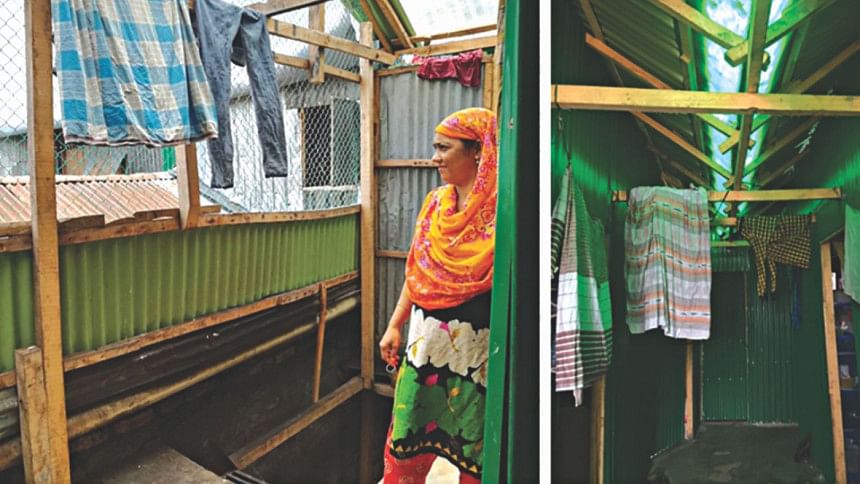How small changes are having a big impact in slums

Last year, on December 11, 115 families of Saat Tola slum, located near ICDDRB, Mohakhali, became homeless after a devastating fire destroyed their improvised houses. A week earlier, a fire broke out at the nearby Korail slum, causing similar loss of property. For the urban poor in Bangladesh, "slum" and "fire" have unfortunately become synonymous.
What happens after the destruction of urban slums by fire? The origin of slum fires often remains unknown. These fire hazards are sometimes accidental and sometimes arson to evict the slum dwellers. Who initiates arson never comes to light. The story of slum fires dissipates fast. In the wake of media coverage, typically there are some quick rehabilitation efforts but nothing long-term happens. Life goes on and slum dwellers return to the same rituals of everyday struggle for survival.
Trends have been changing lately. Some socially-conscious and empathetic architects, planners, NGOs, researchers, and activists have come forward and intervened to improve the lives of slum dwellers.
Disasters and calamities—natural and manmade—always bring sorrow. However, some good can also emerge from disasters. Economist Joseph Schumpeter's notion of "creative destruction"—a constant process of destruction of the old and emergence of the new—is an apt metaphor for slum improvement. Ironically, slums destroyed by arson open up new possibilities for creative intervention.
After the fire in Saat Tola slum, we, along with a group of architects, planners, engineers, together with architecture students from different universities in Dhaka, went to study the damage caused by fire and the condition of the fire victims. While working on this informal settlement, some intriguing questions came to mind.
First, what and how much can we, as professionals, do for slum dwellers? Next, if we do something for them, are they ready or capable to accept or afford these proposed changes? We tried to assist them in their house rebuilding processes by providing some design solutions, ranging from small interventions like using jail windows (for more light) to large interventions like creating open spaces for community gathering or constructing double-storied houses.
As a result of our efforts we found some new insights into how slum dwellers adapt to outside design interventions. We observed that communities are willing to accept cost-effective, short-term solutions as opposed to expensive long-term design interventions, which may not bring immediate improvements to their lives. In a nutshell, micro interventions are likely to be accepted more readily than macro interventions. Why?
Slum dwellers are more likely to understand and accept the proposed changes that yield tangible benefits. They do not accept what they do not see through the lens of their everyday economic practices. Small modifications, such as widening the alleys, minor adjustment to room size, a single window, a hygienic toilet, and a slightly bigger kitchen, can bring a huge change in their everyday lives.
Oazifa Begum, a local resident, states that after replacing the corrugated tin wall with metal jali in the corridor, the space is full of light and air. To her, it is much better. These interventions may sound small, but in reality, sometimes these small solutions prove to be lifesavers. For example, a slightly wider road allows fire trucks to navigate more easily and put off the fire. Ambulances can come to their aid during emergency situations. In short, easy and small changes make sense to them.
As slum dwellers typically do not own the land, they always live in fear of eviction. Hence, they are reluctant to invest in long-term solutions even if these make their living conditions better in the long run. As opposed to micro interventions, macro solutions such as creating open community spaces, vertical extension of their dwellings, and infrastructures like water supply system do not always encourage the slum dwellers because they feel that their future is uncertain.
Lessons learnt: an effective intervention in the lives of slum dwellers may begin with small steps. It is important to understand the everyday practices of slum dwellers, rather than impose on them what professionals think slum dwellers need. Architects, planners and researchers must try to understand slum dwellers from the internal dynamics of how an informal settlement functions. Slum dwellers tend to accept what they view as immediate benefits to their daily lives. Professionals must anthropologically consider what these marginalised people need and what they can afford. It is true that a combination of slum dwellers' perception and professionals' knowledge is what's necessary. Once the slum dwellers realise the positive results of open spaces, wider roads, well-lit and airy spaces, they will perhaps be ready to sacrifice a part of their earnings for a better and healthy lifestyle.
Sheikh Rubaiya Sultana is an assistant professor in the Department of Architecture, BRAC University. Sadia Subrina is a senior lecturer in the Department of Architecture, BRAC University.





Comments